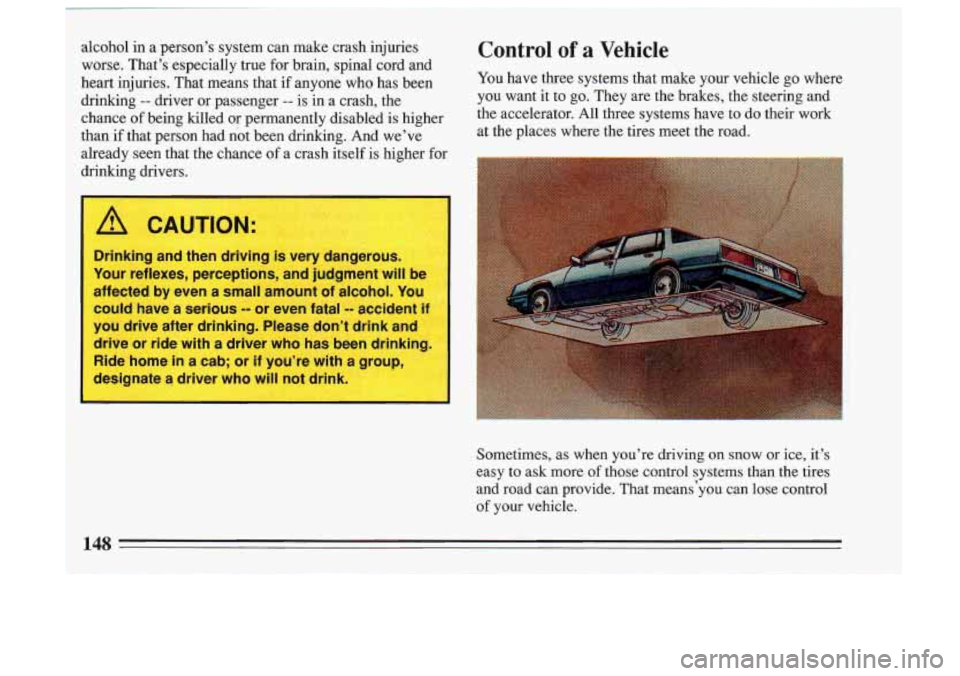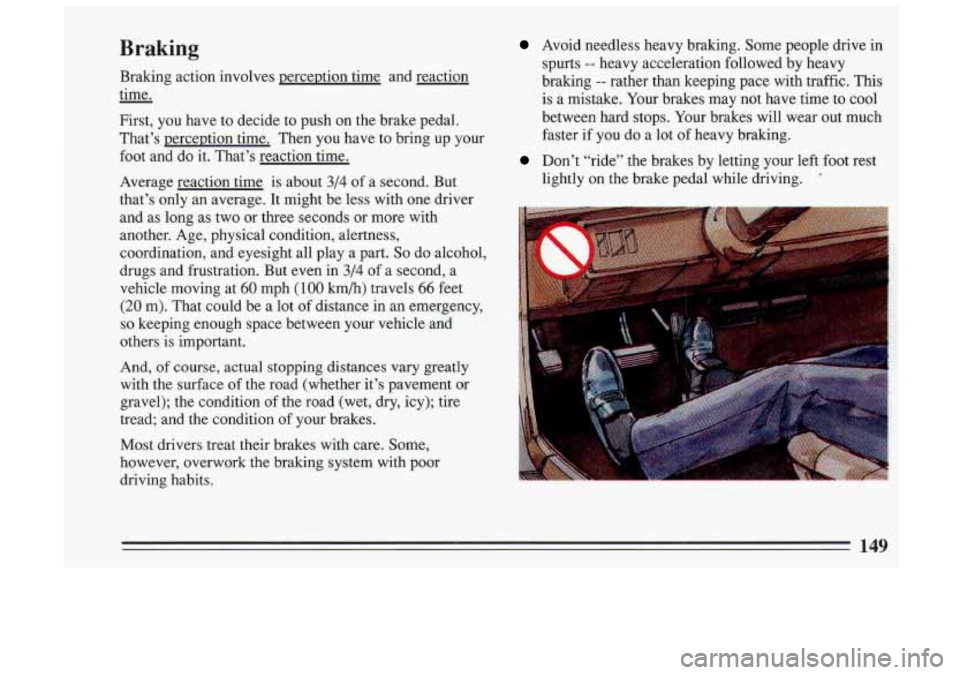Page 80 of 306
2 (Second Gear)
This position gives you more power but lower fuel
economy. You can use
“2” on hills. It can help
control your speed as you go down steep mountain
’
roads, but then you would also want to use your
brakes
off and on.
1 (First Gear)
This position gives you even more power (but lower
fuel economy) than
“2.” You can use it on very steep
hills, or in deep snow or mud.
If the selector, lever is
put in
“1,” the transaxle won’t shift into first gear
until the vehicle
is going slowly enough. ,
Don’t drive in “2” (Second Gear) for more than 5
miles (8 km), or at speeds over 55 mph (88 km/h),
or you can damag ansaxl
much as possible.
Don’t shift into “2” unless you are going
slower
than 65 mph (105 km/h), or you can damage your
engine.
79
Page 81 of 306
The parking brake uses the brakes on the rear wheels.
1
To release the parking brake:
Hold the regular brake pedal down. Pull the brake
release lever.
80
Page 94 of 306
Cruise Control (Option) When you apply your brakes, the Cruise Control shuts
off.
A CAUTION:
0 Cruise Control can be dangerous where
you can’t drive safely at
a steady speed.
So, don’t use your Cruise Control on
winding roads
or in heavy traffic.
With Cruise Control, you can maintain a speed of about
25 mph (40 km/h) or more without keeping your foot on
the accelerator. This can really help on long trips. Cruise
Control does not work at speeds below about
25 mph
(40 m).
I Cruise Control can be dangerous on
slippery roads. On such roads, fast
changes in tire traction can cause n dless
wheel spinning, and you could lose
control. Don’t use Cruise Control on
slippery roads.
93
Page 112 of 306

This light will also come on when you set your parking
brake, and will stay on
if your parking brake doesn’t
release fully. If it stays on after your parking brake is
fully released, it means you have a brake problem.
If the
light comes on while driving, pull
off the road and stop
carefully, You may notice that the pedal is harder to
push. Or, the pedal may go closer to the floor. It may
take longer to stop. If the light is still on, have the
vehicle towed for service. (See “Towing Your
Car” in
the Index.)
-
1
I A CAUTION:
Your brake system may not be working properly
if the brake warning light is on. Driving with the
brake warning light on can lead to an accident. If
the light is still on after you’ve pulled off the road
and stopped carefl
r, have the vehicle towed for
service.
I
Anti-Lock Brake System Warning Light
ANTI.-
LOCK
With anti-lock, this light will go on unless you start your
engine and it will stay on for three .seconds. If the light
doesn’t come on, have it fixed
so it will be ready to
warn
you if there is a problem.
If the light stays on or comes on when you’re driving,
stop as soon
as possible and turn the key off. Then start
the engine to reset the system. If the light still stays on,
or comes on again while you’re driving, your Buick
needs service. Unless the regular brake system warning
light is also on, you will still have brakes, but not
anti-lock brakes. If the regular brake system warning
111
Page 149 of 306

alcohol in a person’s system can make crash injuries Control of a Vehicle
worse. That’s especially true for brain, spinal cord and
heart injuries. That means that if anyone who has been You have three systems that make
your vehicle go where
drinking
-- driver or passenger -- is in a crash, the you want it to go. They are the brakes, the steering and
than if that person had not been drinking. And we’ve
at the places where the tires meet the road.
already seen that the chance of a crash itself is higher for
drinking drivers. chance
of being
filled or permanently disabled is higher the accelerator. All three Systems have to do their work
L
A CAUTION:
-
*. ,
Drinking and then driving is very dangerous.
Your reflexes, perceptions, and judgment will be
affected by even a small amount
of alcohol. You
could have a serious
-- or even fatal -- accident i 1
you drive after drinking. Please don’t drink an
drive or ride with a driver who has been drinking.
1;
Ride home in a cab; or if you’re with a group,
designate
a driver who will not drink.
Sometimes, as when you’re driving on snow or ice, it’s
easy
to ask more of those control systems than the tires
and road can provide. That means‘you can lose control of your vehicle.
148
Page 150 of 306

Braking
Braking action involves perception time and reaction
time.
-
First, you have to decide to push on the brake pedal.
That’s perception time. Then you have to bring up your
foot and do it. That’s reaction time.
Average reaction time is about
3/4 of a second. But
that’s only an average. It might be less with one driver
and as long as two or three seconds or more with
another. Age, physical condition, alertness, coordination, and eyesight all play a part.
So do alcohol,
drugs and frustration. But even in
3/4 of a second, a
vehicle moving at
60 mph (100 km/h) travels 66 feet
(20 m). That could be a lot of distance in an emergency,
so keeping enough space between your vehicle and
others is important.
And, of course, actual stopping distances vary greatly
with the surface of the road (whether it’s pavement or
gravel); the condition of the road (wet, dry, icy); tire
tread; and the condition of your brakes.
Most drivers treat their brakes with care. Some,
however, overwork the braking system with poor
driving habits.
Avoid needless heavy braking. Some people drive in
spurts
-- heavy acceleration followed by heavy
braking
-- rather than keeping pace with traffic. This
is a mistake. Your brakes may not have time to cool
between hard stops. Your brakes will wear out much
faster if you do a lot
of heavy braking.
Don’t “ride” the brakes by letting your left foot rest
lightly on the brake pedal while driving.
*
149
Page 151 of 306

I A CAUTION.:
“Riding” your brakes can cause them to overhe;
to the point that they won’t work well. You mighl
not be able to stop your vehicle
in time to avoid
an accident. If you “ride” your brakes, they will
get
so hot they will require a lot of pedal fol- -
slow you. down. Avoid “riding” the brakes.
If you keep pace with the traffic and IW realistic
following distances, you will eliminate a lot
of
unnecessary braking. That means better braking and
longer brake life.
If your I- -dine ever stops while you’re driving, brake
normally but don’t pump your brakes.
If you do, the
pedal may get harder to push down.
If your engine
stops, you will still have some power brake assist.
But you will use it when you brake. Once the power
assist
is used up, it may take longer to stop and the
brake pedal will be harder to push.
Anti-Lock Brakes (ABS)
Your Buick has an advanced electronic braking system
that will help prevent skidding.
This light on the instrument panel will go on when you
start your vehicle.
TI-
LOCK
150
Page 152 of 306
When you start your vehicle and begin to drive away,
you may hear a momentary motor or clicking noise. And you may even notice that your brake pedal moves a little
while this is going on. This
is the ABS system testing
itself.
If you have your foot on the brake pedal, this
check won’t happen until the vehicle goes about 4.mph
(6 km/h) or until you take your foot off the brake pedal.
After an ABS stop, you may hear a clicking noise the
next time the vehicle goes about
4 mph (6 km/h).
If there’s a problem with the anti-lock brake system, the
anti-lock brake system warning light will stay on or
flash.
See “Anti-lock Brake System Warning Light” in the
Index.
Here’s how anti-lock works. Let’s say the road is wet.
You’re driving safely. Suddenly an animal jumps out in
front of you.
You slam on the brakes. Here’s what happens with
ABS.
151
~